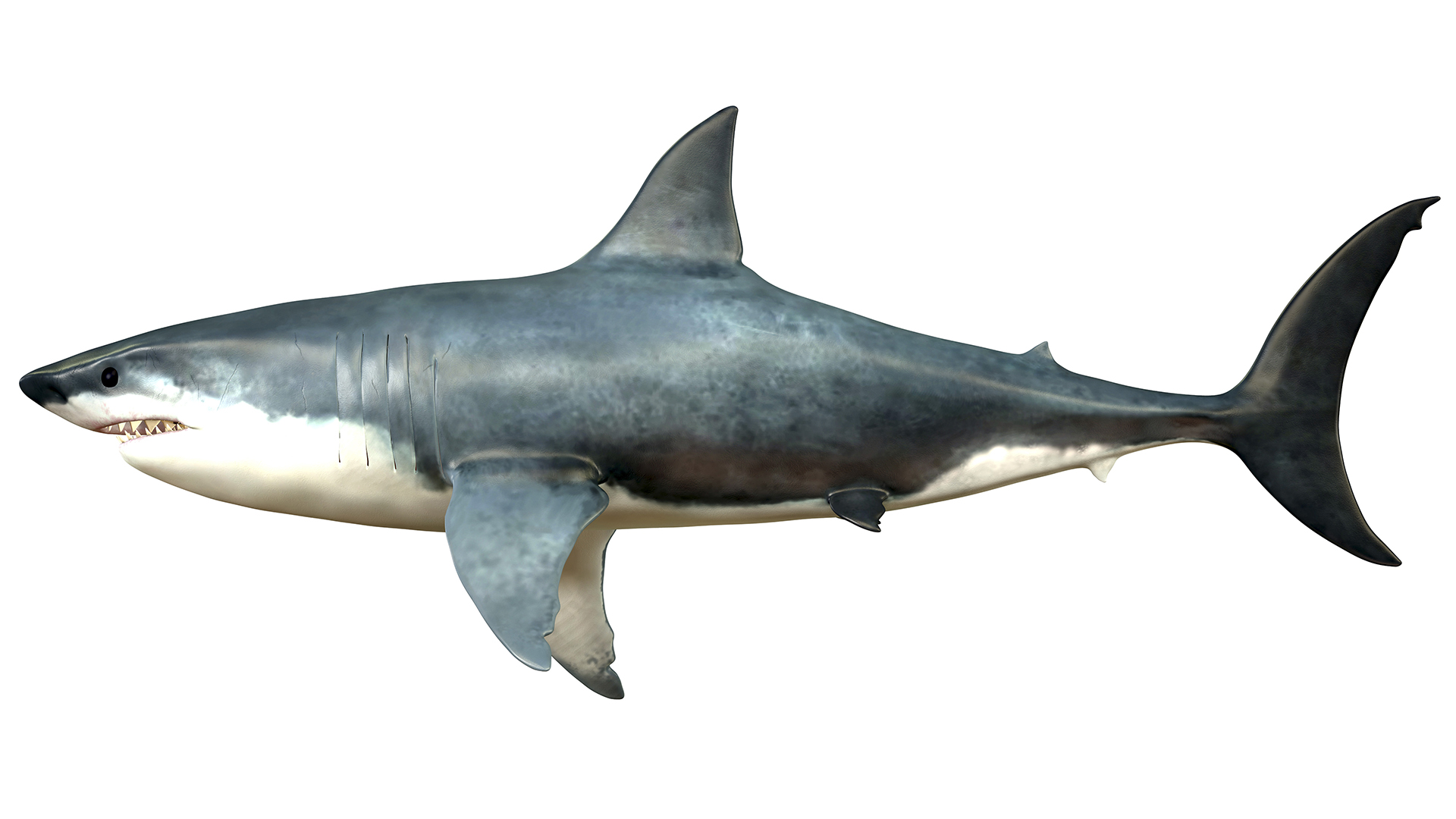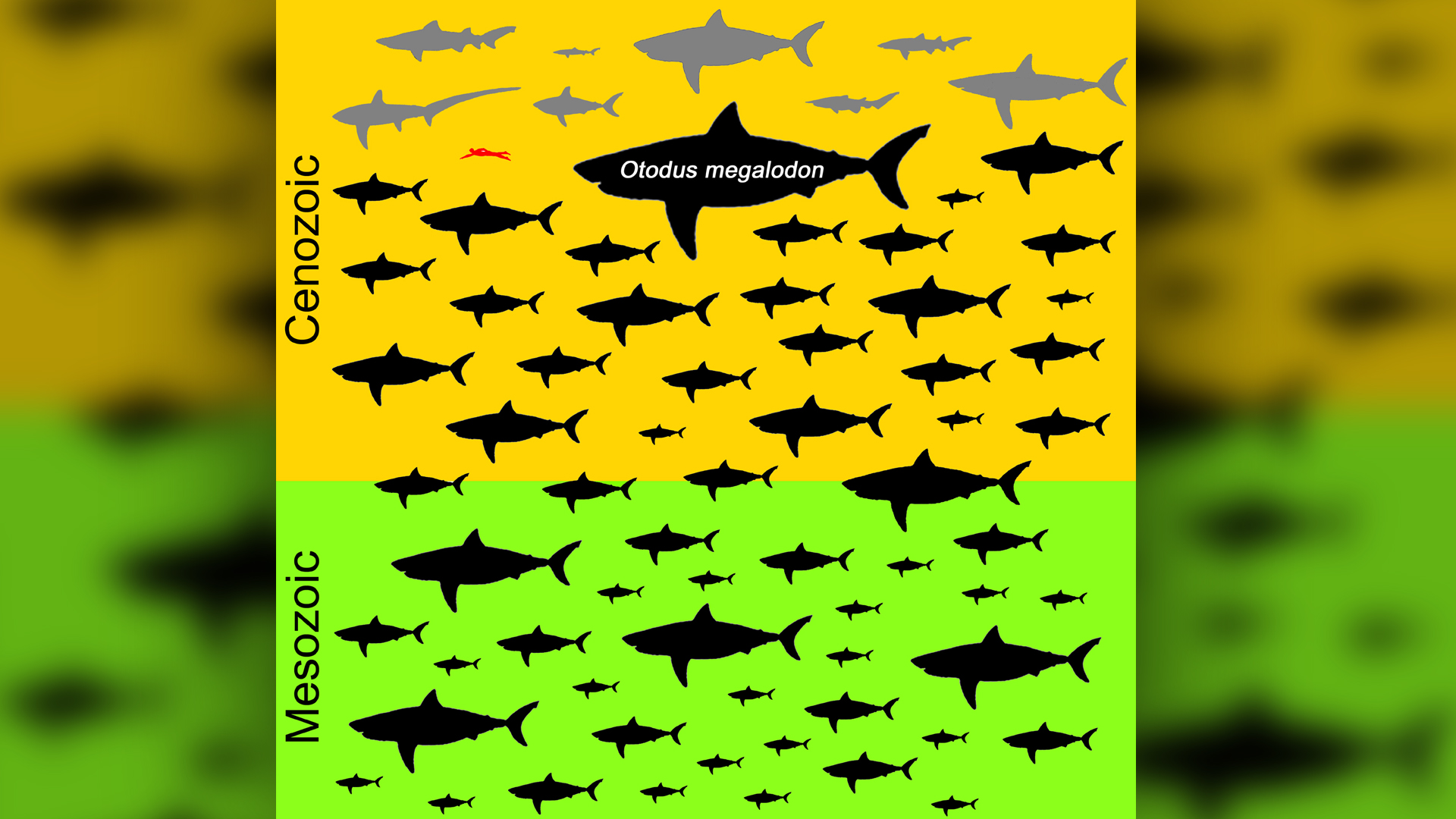Megalodon's hugeness was 'off-the-scale' — even for a shark
Even among its extinct relatives, Megalodon was unequalled in length and mass.

Megalodon was the most massive shark that ever lived, and its gargantuan girth was highly unusual even among sharks, scientists recently discovered.
In fact, Megalodon's gigantism — it's estimated to have measured up to 50 feet (15 meters) in length, about as long as a bowling lane — was "off-the-scale," researchers wrote in a new study.
Evidence from extinct and living sharks in the order Lamniformes, the group that includes Megalodon, revealed that not only was the king of sharks an extreme outlier when compared with modern species; it was also substantially bigger than the next-biggest extinct shark in the Lamniformes order by at least 23 feet (7 m), the scientists reported.
Related: 7 unanswered questions about sharks
Modern sharks are comparative pipsqueaks next to Megalodon (Otodus megalodon). The biggest known predatory species, the great white shark (Carcharodon carcharias), grows to only about 20 feet (6 m) long, and the filter-feeding whale shark (Rhincodon typus), the biggest fish species alive today, measures about 18 to 33 feet (6 to 10 m) from nose to tail tip, on average. (However, the biggest known whale shark measured a whopping 62 feet (19 m) long, researchers reported in 2015 in the journal PeerJ.)
There are 13 species of lamniform sharks alive today; these include mako sharks (the Isurus genus), deep-sea goblin sharks (Mitsukurina), and thresher sharks (Alopias), as well as great whites.
Most Megalodon fossils date to around 15 million years ago, and lamniforms were plentiful from the end of the Mesozoic era (252 million to about 66 million years ago) into the early Cenozoic era, (65 million years ago to the present). However, little is known about the anatomy of extinct lamniforms; since shark skeletons are made of cartilage rather than bone, they are extremely scarce in the fossil record, save for their plentiful fossilized teeth, said lead study author Kenshu Shimada, a professor of paleobiology at DePaul University in Chicago and a research associate at the Sternberg Museum in Kansas.
Sign up for the Live Science daily newsletter now
Get the world’s most fascinating discoveries delivered straight to your inbox.
Tooth size can be used to estimate a shark’s body size because as sharks grow they continuously replace their teeth, getting new and bigger ones over time. In the new study, Shimada and his colleagues generated a new tool for calculating body length: an equation representing the actual quantitative relationship between body length and tooth size in lamniforms. They based it on the teeth and known body lengths from 32 specimens of living, predatory lamniform sharks, representing all 13 species that are not plankton-eaters, Shimada told Live Science in an email. They then applied their equation to extinct predatory lamniforms.

The scientists found that many extinct lamniform sharks were quite large, with four Mesozoic genera (Cretodus, Cretoxyrhina, Hispidaspis and Scapanorhynchus) and four Cenozoic genera (Alopias, Carcharodon, Isurus and Otodus) holding at least one shark species that grew to more than 20 feet (6 m) in length.
Why does this group have so many supersize sharks? Their gigantism may be fueled by a reproductive strategy: Bearing live young "with a unique cannibalistic egg-eating behavior" that nourishes early-hatching embryos, enabling them to grow large while still inside their mothers by feeding on their siblings, Shimada said in the email.
But even though the researchers found that gigantism was common in multiple lamniform lineages, Megalodon dwarfed extinct sharks, too.
"We expected Megalodon to be large," Shimada said. What they did not predict was that there would be a gap of 23 feet (7 m) between Megalodon and the next-largest predatory lamniform shark in the fossil record, he said. According to their calculations, all other lamniforms that did not eat plankton grew no bigger than 23 feet in length, the authors reported.
While the Megalodon picture is now a little clearer than it was before, many fundamental questions about the size of the massive super-shark are still unanswered, such as the particulars of its body structure and what caused Megalodon’s over-the-top gigantism, Shimada said.
"Why Megalodon became extinct is another big fundamental question that remains unsettled," he added.
The findings were published online today (Oct. 5) in the journal Historical Biology.
EDITOR'S NOTE: The article was updated on Oct. 7 to include the length of the biggest confirmed whale shark.
Originally published on Live Science.

Mindy Weisberger is an editor at Scholastic and a former Live Science channel editor and senior writer. She has reported on general science, covering climate change, paleontology, biology and space. Mindy studied film at Columbia University; prior to Live Science she produced, wrote and directed media for the American Museum of Natural History in New York City. Her videos about dinosaurs, astrophysics, biodiversity and evolution appear in museums and science centers worldwide, earning awards such as the CINE Golden Eagle and the Communicator Award of Excellence. Her writing has also appeared in Scientific American, The Washington Post and How It Works Magazine. Her book "Rise of the Zombie Bugs: The Surprising Science of Parasitic Mind Control" will be published in spring 2025 by Johns Hopkins University Press.









